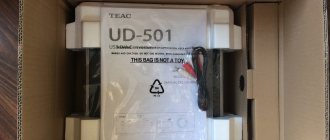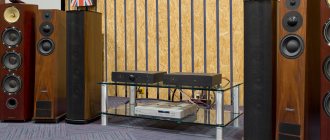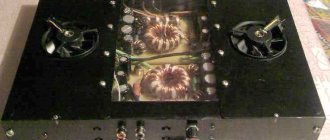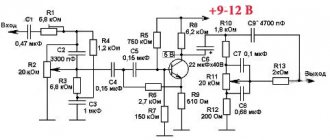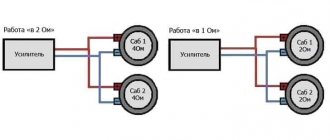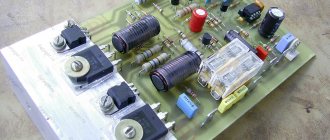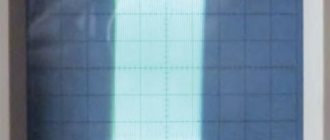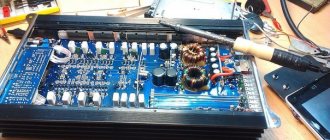This project examines headphone amplifiers based on mass-produced microcircuits, such as TDA2003, BA5415A and BA5417.
I refrained from philosophical discussions about which of the presented sound reproduction schemes is “more correct.” The purpose of the experiments is different - to provide worthy schemes for repetition, and enthusiastic readers will make their own choice and share their impressions.
↑ Headphone amplifier on TDA2003 chip
A review of amateur radio publications published in the magazine “Radiohobby” reports on Aren van Waerde’s successful experiment on using the widespread and cheap “automotive” microcircuit TDA2003 (analogue - K174UN14) as an amplifier for 32-ohm headphones, Fig. 1[1].
Rice. 1. Scheme of Arena van Waerde. Amplifier for stereo phones (one channel)
The author found that when powered from a unipolar 12 V source (quiescent current 40 mA), the amplifier operates in class A up to an output power of several hundred milliwatts. At the same time, the amplifier's transmission coefficient is reduced by more than five times compared to a typical microcircuit connection (from 100 to 18) without losing the stability of the circuit.
For such a simple circuit (Fig. 1) quite good characteristics were obtained:
Operating frequency range with characteristic unevenness ±3 dB: 14...30000 Nominal load impedance: 32 Ohm Harmonic distortion: 0.006% Noise level: –100 dB Maximum output power at 32 Ohm load: 200 mW Gain at 1000 Hz: 24.8 dB
Shown in Fig. 1 diagram is a basic topological one - it shows the connection point of common wires, which simplifies the implementation of the design “in hardware”.
The corrected circuit diagram of the amplifier in a design familiar to the Russian radio amateur is shown in Fig. 2. Based on the results of prototyping, the amplitude-frequency response correction circuit R3, C5 is connected as recommended in a typical connection of the TDA2003 microcircuit, namely, between its pins 2 and 4.
Rice. 2. Adjusted amplifier circuit for stereo phones on TDA2003, TDA2002
The sensitivity from the input is about 100 mV, the amplifier is suitable for headphones with a resistance of 32 to 100 Ohms.
In position DA1 you can also install the TDA2002 chip. Resistors MLT, OMLT, S2-23, S2-29, S2-33N, MON or imported, with a power not lower than that indicated on the circuit diagram. Capacitors C3, C7 film type K73-17, K73-24 or imported MKT; capacitor C5 is ceramic. Choose high-quality oxide capacitors, designed for temperatures up to +105°C.
Amplifier parts, two channels
DA1 - TDA2003 chip - 2 pcs., R1 - Res.-0.125-130 Ohm - 2 pcs., R2, R3 - Res.-0.125-2.2 kOhm - 4 pcs., R4 - Res.-0.5- 1 Ohm - 2 pcs., C1 - Cond.10/25V 0511 105°C - 2 pcs., C2, C6 - Cond.470/25V 1013 105°C - 4 pcs., C3 - Cond.0.22/63V K73-17 - 2 pcs., C4 - Cond.1000/25v 1020+105°C - 2 pcs., C5 - Cond. 2200 pF NPO ceramic imp. - 2 pcs., C7 - Cond.0.1/63V K73-17 - 2 pcs., Terminal block TV-12A 2K pitch 5 mm per board - 6 pcs., Double variable resistor ALPS 33 - 50 kOhm - 1 pc., Resistor 1 kOhm 0.25 W - 2 pcs., Power cable ShVVP 2×0.75 - 0.5 m, Fluoroplastic wire MGTF 0.75 - 0.5 m, Heat-shrinkable tube d=5 mm - 0.5 m, Double asymmetrical shielded OFC cable 2×0.14 sq mm - 0 .5 m., Printed circuit board (for two channels) 96×38 mm - 1 pc.
Rice.
3(a) Placement of elements on a printed circuit board I recommend installing TDA2003 microcircuits on small radiators
25 mm high, cut from an aluminum profile for general construction purposes (channel) 10x20x10x2 mm.
Rice. 3(b) Connection diagram of an amplifier for stereo phones on a TDA2003 chip
↑ Headphone amplifier on BA5415A chip
The BA5415A chip was included in the list of those recommended for use in a headphone amplifier by chance.
Our local poet and bard Sergei Alekseevich Krugovykh, inspired by another trip to Druksiai, was busy perpetuating his works on a personal computer, and complained to me about the lack of a headphone jack in his computer active speaker systems.
For those who don’t know, Druksiai is a picturesque place in Belarus, where every year, since August 1967, teams from Tallinn, Riga, Siauliai, Minsk, Moscow, Veliky Novgorod and other cities gather. These cheerful and friendly people come to meet and relax. The song competition “Druksiai Dawns” is traditional.
In order not to frighten the poet’s insight, I immediately began to improve his workplace: I purchased a telephone jack, found a dozen resistors (to be selected as current-limiting resistors at the output of the amplifier) and gave him my second TDS-5 headphones. The results of the upgrade exceeded all expectations - the sound in the headphones turned out to be extremely wonderful, so I sketched the diagram in my notebook (Fig. 4).
Rice. 4. Schematic diagram of a stereo headphone amplifier based on the BA5415A chip
Characteristics of the amplifier based on the BA5415A microcircuit from Rohm:
Output power: 3 W (4 Ohms) Sensitivity: 100...150 mV Input impedance: 47 kOhm Frequency range: 20...20000 Hz Load impedance: 3...250 Ohms Total harmonic distortion: 0.06% Signal-to-noise ratio: 86 dB (A) Quiescent current: 30mA
A volume control is installed at the input - a dual variable resistor with a resistance of 47 kOhm. The gain of a microcircuit with negative feedback can be set in the range of 33...45 dB by changing resistor R2 (R3) in the feedback circuit:
Ku=20lg[1+44/(R2(R3))], where R2 (R3) is the resistance of the external resistor, kOhm.
Later, on the Internet, I found information that the BA5415A (High - output dual power amplifier) chip is used in the ERGO AMP 1 headphone amplifier from the Swiss company Precide with an external power supply of 15...18 V/0.5 A, a volume control of 22 kOhm, fig. . 5. The external adapter contains a power transformer, and a diode bridge and a stabilized power supply (chip 7812, capacitors 5 × 1000 μF x 25 V = 5000 μF) are placed on the amplifier printed circuit board. Case dimensions 20x7x18 cm, weight 1.1 kg.
Rice. 5. Appearance of the ERGO AMP 1 headphone amplifier with the cover removed
The amplifier does not contain scarce components; they can be purchased at radio stores.
Elementary base of a headphone amplifier based on BA5415A
DA1 - Chip BA5415A - 1 pc., R1, R2 - Res.-0.25-33 kOhm - 2 pcs., R3...R6 - Res.-0.25-1.0 kOhm - 4 pcs., R7, R8 — Res.-0.5-1.5 Ohm — 2 pcs., C1, C2 — Cond. 10/25V 0511 +105°C — 2 pcs., C3…C6 — Cond. 100/25V 0812 +105°C — 4 pcs., C7, C8 — Metal film capacitor K73-17 imp, 0.1 uF, 63 V, 10%, POLYESTER BOXED, B32529C0104K000 — 2 pcs., C9, C11, C12 — Cond.1000/25V 1021+105 °C - 3 pcs., C10 - Cond. 220/25V 0812 105°C - 1 pc., 3k plug. on PLS-3 2.54 board - 1 pc., JP-2 jumper for pin strips and connectors, pitch 2.54 mm - 1 pc., Printed circuit board 75x50 mm - 1 pc.
The printed circuit board for the amplifier (Fig. 6) is designed based on the Data Sheet of the BA5415A chip.
Rice. 6. Placement of elements on the printed circuit board
The BA5415A stereo amplifier chip is installed on a small plate - a heat sink (Fig. 7).
Rice. 7. Heat sink for BA5415A chip. Material: duralumin 3…6 mm thick
First launch and tests
To begin with, it is worth checking the correctness of installation, ringing adjacent tracks for short circuits. If everything is assembled correctly, we supply power to the board by connecting the speaker and leaving the signal input unconnected. In this case, it is advisable to turn the volume control to the minimum position so that the input of the microcircuit is connected to ground. We supply power to the board, the LED should light up immediately.
Now we carefully turn the volume control; you should hear a slight crackling sound in the speaker, because the input is now “hanging in the air.” This means that the chip is working - now you can input music, for example, from a player, phone or computer. You can connect such an amplifier to any speakers with a resistance of 4-16 Ohms; the lower the speaker resistance, the greater the output power, and, accordingly, the heating of the microcircuit. Happy building!
Downloads: 524, size: 15.7 KB, date: 25.Feb.2019
↑ Headphone amplifier on BA5417 chip
Just like the previous one, the BA5417 microcircuit is designed for building amplifiers for radios and cassette players with a supply voltage from 6 to 15 V. The headphone amplifier circuit is shown in Fig. 8.
Rice. 8. Headphone amplifier based on BA5417 chip
In the BA5417 microcircuit, my attention was drawn to the presence of separate common signal “grounds” in each of the channels (pins 14 and 15 of the microcircuit), as well as a power common wire (pin 7 of the microcircuit), which allows us to hope for better amplifier characteristics.
The transmission coefficient of the feedback circuit (43...47 dB) is determined by the ratio of resistors inside the microcircuit and external resistors:
Ku=20lg[1+30000/(45+R1(R2))], where R1 (R2) is the resistance of the resistor, Ohm.
Capacitors C5 and C6 operate in “voltage booster” circuits; there are Zobel circuits (R3, C9 and R4, C10) to prevent self-excitation during the reactive nature of the load.
The microcircuit is equipped with a Stand by input; when its voltage is above 3.5 V, the operating mode is activated, and when the voltage is less than 1.2 V, the amplifier switches to low power consumption mode (20 μA).
Characteristics of the amplifier on the BA5417 chip:
Output power: 3.5 W (4 Ohm) Sensitivity: 20…50 mV Input impedance: 33 kOhm Reproducible frequency range: 20…20000 Hz Load resistance: 3…250 Ohm Nonlinear distortion factor (Rн=32 Ohm, Рout=0, 25 W): 0.08% Signal to noise ratio: 85 dB(A) Quiescent current: 22 mA
It should be remembered that the capacitance values of the oxide capacitors in the circuit affect the time it takes to establish the DC operating modes of the amplifier after turning on the power. With the capacitor ratings indicated in the diagram (Fig. it does not exceed 0.8 s.
Headphone amplifier parts for BA5417
DA1 - BA5417 chip, HSIP15 housing - 1 pc., R1, R2 - Res.-0.25-160 Ohm - 2 pcs., R3, R4 - Res.-0.5-2.2 Ohm - 2 pcs., R5, R6 — Res.-0.25-1.0 kOhm — 2 pcs., R7, R8 — Res.-0.5-1.5 Ohm — 2 pcs., C1, C2 — Cond. 10/25V 0511 +105°C — 2 pcs., C3, C4 — Cond. 330/25V 0812 +105°C — 2 pcs., C5, C6, C8 — Cond. 100/25V 0812 105°C — 3 pcs., C7, C11, C12 — Cond. 1000/25V 1321 (1021) +105°C — 3 pcs., C9, C10 — Cond. 0.15/63V K73-17 — 2 pcs., 3k plug. on PLS-3 2.54 board - 1 pc., JP-2 jumper for pin strips and connectors, pitch 2.54 mm - 1 pc., Printed circuit board 70x50 mm - 1 pc.
In Fig. Figure 9 shows the placement of parts on the amplifier printed circuit board on the BA5417 chip.
Rice. 9. Arrangement of elements on the amplifier printed circuit board
Try making two power supplies to practically evaluate its effect on the sound of the amplifier.
A little trick of the TDA2003 chip (K174UN14)
Many devices use the UMZCH TDA2003 (K174un14) microcircuit; usually these are only devices powered from a lighting or automotive network. The use of the TDA2003 (K174un14) integrated circuit in portable equipment is limited by its high quiescent current.
Moreover, most of the quiescent current is spent not on the microcircuit itself, but on heating the constant resistors in the negative feedback circuit for alternating current, since these resistors, forming a total resistance of about 20 Ohms (according to a typical circuit), are under a constant voltage of the microcircuit output equal to half power supply voltage.
As a result, with a supply voltage of 9 volts, an excess current of 0.023 Amperes is obtained. The problem can be radically solved if the negative feedback from the output is cut by direct current, as shown in the figure. In this case, the operation of the microcircuit will not be disrupted in any way, and the quiescent current is significantly reduced.
↑ Power supply based on an integrated stabilizer with a fixed output voltage
made on the K142EN8B chip (12 V±3%), you can also supply K142EN8D (12 V±4%) or foreign LM7812.
The schematic diagram is shown in Fig. 10. The DA1 voltage stabilizer chip can be installed without a radiator, but experience suggests that it is better to install them on small radiators (TO-220 micro-Uheatsink).
Fig. 10. Schematic diagram of the power supply: C1…C4 type K73-17 for an operating voltage of 630 V; C6, C7 type K73-17 for operating voltage 63 or 250 V
Capacitors C1 - C4 bypass the bridge diodes VD1 - VD4, which makes it possible to suppress pulsed high-frequency interference, both generated by the bridge diodes and penetrating from the household network (~ 220 V, 50 Hz) through the step-down transformer T1.
Capacitors C5 and C6 are used for additional filtering of the output voltage, which ensures stable operation of the DA1 chip.
LED HL1 indicates the presence of output voltage. Chain R1, HL1 allows you to discharge the electrolytic capacitors of the power supply when there is no load.
The power supply parts are located on the printed circuit board, Fig. eleven.
Rice. 11. Possible version of the power supply circuit board
Amplifier assembly on TDA2003
The entire circuit is assembled on a small printed circuit board measuring 45 x 55 mm, which can be made using the LUT method. The printed circuit board is completely ready for printing on a laser printer and does not require mirroring. After transferring the board, we put it in the etching solution and after etching we get the same result as in the photo below.
Now all that remains is to erase the toner layer, drill holes and tin the tracks and you can start soldering the parts. First of all, small parts are installed - resistors and small capacitors, then everything else. To connect the power wires, speaker and audio source, it is most convenient to use screw terminal blocks, which is what I did. Last but not least, a radiator is installed on the chip; you can use absolutely any one that fits the size of the board.
↑ Power supply on the LM317 adjustable stabilizer chip
shown in Fig.
12. Resistors R1, R2 form an external adjustable voltage divider, with the help of which the output voltage of the stabilizer is set: Uout=1.25(1+R2/R1)+IpotR2, where Ipot=50...100 μA is the microcircuit’s own current consumption. In this formula, the number 1.25 is the reference voltage between the output and the control pin, maintained by the stabilizer in operating mode.
Rice. 12. Power supply on an adjustable stabilizer chip LM317
The minimum output current value (about 10 mA) required for reliable operation of the DA1 stabilizer is provided by the divider R1, R2 and the circuit R3, HL1.
Capacitor C7 serves to reduce ripple at the output of the stabilizer. Diodes VD5, VD6 are protective. The first of them, the VD5 diode, protects against high reverse voltage from the load, which can damage the microcircuit and occurs when the input circuit is accidentally shorted or the power source is turned off.
Another protective diode, VD6, protects the microcircuit from the side of the charged capacitor C7. The diode discharges capacitor C7 in the event of an emergency closure of the output or input of the stabilizer.
Power supplies use common components. Schottky diodes VD1 - VD4 can be replaced with a diode bridge KBP204, RS204, D2SBA40 (400V/2A), of course, with adjustments to the printed circuit board.
Stabilizer chips in the TO-220 housing are installed on small radiators 25 mm high, cut from an aluminum profile for general construction purposes (channel) 10x20x10x2 mm.
Power transformer T1 - any power 10 - 30 W, allowing you to get a voltage on the secondary winding of 12.5 - 18 V at a current of at least 0.5 A.
Components for power supplies
PSU on IS 7812:
DA1 - Microcircuit KR142EN8B, TO-220 case - 1 pc., VD1...VD4 - Schottky diode 1N5822 (40V/3A), DO-201 case - 4 pcs., VD5 - Diode 1N4004 (400V; 1A), DO-41 case (replacement KD243G) - 1 pc., HL1 - LED LG2040 d=3mm green - 1 pc., R1 - Res.-0.25-2.7 kOhm - 1 pc., C1...C4 - Cond.0.01 /630V K73-17 - 4 pcs., C5 - Cond.4700/25V 1625+105°C - 1 pc., C6, C7 - Cond.0.1µ/63V J K73-17(imp.) - 2 pcs. , C8 - Cond. 22/25V 0511 +105°C - 1 pc., X1, X2 - Terminal block TV-12A 2K pitch 5 mm per board - 2 pcs., Printed circuit board 70x33 mm - 1 pc.
PSU on IC LM317:
DA1 - LM317BT chip, TO-220 package - 1 pc., VD1...VD4 - Schottky diode 1N5822 (40V/3A), DO-201 package - 4 pcs., VD5, VD6 - Diode 1N4004 (400V; 1A), DO-41 housing (replacement for KD243G) - 2 pcs., HL1 - LED LG2040 d=3mm green - 1 pc., R1 - Res.-0.25-120 Ohm - 1 pc., R2 - Res. -0.25-1.0 kOhm - 1 pc., R3 - Res. -0.25-2.7 kOhm - 1 pc., C1...C4 - Cond.0.01/630V K73-17 - 4 pcs. , C5 - Cond.4700/25V 1625+105°C - 1 pc., C6, C8 - Cond.0.1µ/63V J K73-17 (imp.) - 2 pcs., C7, C9 - Cond. 22/ 25V 0511 +105°C - 2 pcs., X1, X2 - Terminal block TV-12A 2K pitch 5 mm per board - 2 pcs., Printed circuit board 70×33 mm - 1 pc.
In Fig.
Figure 13 shows the placement of the power supply elements on the adjustable stabilizer chip on the printed circuit board. A number of measures have been taken to increase the stability of the power supply. To reduce the influence of the load current on the stability of the output voltage, the connections of the common terminals are made as a star at the point of the negative terminal of capacitor C5. For the same purposes, the upper (according to the circuit diagram in Fig. 12) output of resistor R1 is connected by a separate track to the output of the stabilizer chip DA1.
The lengths of the conductors from the input capacitor C5 to the microcircuit, as well as from the output of the microcircuit to the oxide capacitor C9, have been minimized. Film capacitors C6 and C8 are located directly at the terminals of the stabilizer microcircuit.
Rice. 13. Location of power supply elements with LM317 on the printed circuit board
When manufacturing power supplies, strictly follow the safety rules set out, for example, in the magazine
“Radio”, 2015, No. 5, p.
54 (Caution! Electric current!) .
Heat-shrinkable tubing is very convenient for insulating live parts, giving the appearance of the ends of shielded cables and other works. Working with this material is simple. Please note that the tube shrinks approximately twice its diameter, and before work, thoroughly degrease the location of the tube. Typically, heat shrink tube has a melting point of about 120ºC, so amateurs often use matches and lighters. It is much more professional to perform this operation using a tool, for example, a mini gas gun (Fig. 14).
Rice. 14. Gas device for shrinking cambric based on a lighter
Amplifier circuit
Sound amplifier 200 watt
The amplifier circuit is simple and does not contain any scarce parts. VR1 is a variable resistor with one group of contacts, used to regulate the sound volume. It is advisable to use a resistor with a logarithmic characteristic for smooth adjustment, but a regular linear one will also work.
The HL1 LED serves to indicate that the amplifier is turned on and lights up immediately when power is applied to the board. The supply voltage of this circuit lies in the range of 8-18 volts, the best option is 12 volts, so all electrolytic capacitors must be taken at a voltage of at least 16 volts, it is advisable to set it higher - 25 volts.
The microcircuit, especially when operating at high volumes, heats up noticeably, so it needs at least a small radiator. Capacitor C5 is connected in series with the speaker and cuts off the DC component in the signal, so DC voltage will not appear on the speaker, even if the microcircuit fails.
↑ Conclusion
All three options are good as instant boosters.
When used with low-impedance headphones (8 - 32 Ohms), the amplifier based on the BA5415A chip has a clear advantage. The proposed amplifiers can be successfully used in radios, tuners, record players and other devices. Amplifiers based on BA5415A and BA5417 microcircuits have excessive sensitivity for modern devices. The amplifiers combine well with a wide variety of signal sources, including sound cards of personal computers and laptops, gain 20...22 dB. For coordination, it can be recommended to connect resistors in series with the volume controls or install passive tone controls in front of the amplifier.
The resistor resistance values will be 82...110 kOhm and 330...430 kOhm, respectively, for the amplifiers shown in Fig. 4 and fig. 8.
I draw the attention of hunters to the fact that the diagram shown in Fig. 8 can be used in conjunction with a directional microphone as a hearing amplifier for hunting.
The supply voltage should be reduced to 6...9 V, and the gain should be increased to 46 - 47 dB by reducing the resistance of resistors R1, R2 to 91...100 Ohms.
↑ Additions from comrades
22/11/2016 Maxim Kurasov / maxkur
:
Signet in Lake, diagram, photo:

